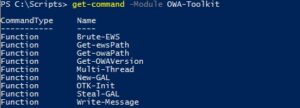Outlook Web Access (OWA) has been one of the consistently viable attack vectors for pentesters and bad guys alike for many years. Frequently, an attacker will obtain valid credentials by brute forcing OWA portals exposed to the internet. Once credentials are obtained an attacker can then access the target network via any other single factor authentication portals that may also be exposed (Citrix, VPN, or *gulp* RDP).
After using multiple brute force tools I began to see some false negatives, so I decided to dive into writing my own tool. I found that many installations of Exchange provide an API through the Exchange Web Service (EWS) and wrote a set of modules to take advantage of that.
The EWS is a convenient API exposed to allow programatic access to someones mailbox and some Exchange functionality (Thanks Microsoft!). To get started using these modules you have to install the Exchange Web Service API (here). Once that is installed get a copy of the OWA-Toolkit from here. Then import the module like so:
Import-module C:\path\to\OWA-Toolkit.psm1
Once you have the module imported you should be able to see what cmdlets it includes:

Decide if you want to brute using user ids or full email addresses and then compile a list of targets. The list should just be a txt file that has one user per line. Then you can invoke Brute-EWS like so (if you want to brute with emails include the Domain parameter):
Brute-EWS -TargetList .\userids.txt -ExchangeVersion 2007_SP1 -ewsPath "https://webmail.yourdomain.com/EWS/Exchange.asmx" -Password "omg123" -Domain "yourdomain.com"
If you so chose you can also pass the UserAsPass parameter to attempt authentication with the userid passed as the password. Once valid credentials are obtained it is common to take the Global Address List (GAL) to use for additional brute forcing or social engineering. This was usually a painful process forcing OWA to load all the addresses while I was proxying it through Burp. So, utilizing the EWS I decided to write a script to take the GAL. To use the Steal-GAL cmdlet you can invoke it like so:
Steal-GAL -Password "littlejohnny" -User "dbetty" -domain "yourdomain.com" -ExchangeVersion 2007_SP1
You can also pipe an exchService object to this cmdlet like so:
OTK-Init -Password "littlejohnny" -User "dbetty" -Domain "yourdomain.com" -ExchangeVersion 2007_SP1 | Steal-GAL
The output is designed to be piped to an output method of your choice; the easiest way I have found is to just add "| export-csv -Path .\gal.csv" to your command. Please provide any feedback or issues you might have to Github. Thanks.